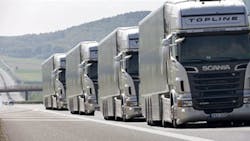Platooning Lets Trucks Get By With a Little Help from Their Friends
In the not so distance future truck drivers will find themselves in close quarters with colleagues. This new pattern of driving, “platooning”, calls for a number of trucks to follow each other very closely so they can take advantage of the aerodynamics and save fuel.
The technology to make all of this happen is a result of collaboration between Peloton, a company that automates tractor-trailers and Omnitracs, a fleet management company.
The lead truck sets the pace. Through the integration of vehicle-to-vehicle (V2V) communications with state-of-the-art, radar-based collision avoidance systems, the technology synchronizes braking and acceleration between pairs of trucks. This communication ensures that the trucks travel safely at aerodynamic following distances.
For the driver of the follow truck, the Peloton system works similarly to adaptive cruise control with the added safety feature of V2V communications to enable automated braking within 0.1 second of braking by the lead truck. The driver of each truck controls steering while the platooning system coordinates speed and distance between the trucks-- meeting the definition of SAE Level 1 automated driving.
Platoons are managed continuously by a cloud-based Network Operations Center that connects to trucks through cellular and Wi-Fi communications. Cloud-based supervision limits operation of platoons to specified roads in safe driving conditions.
Peloton said the system generates 4.5% fuel savings for the lead truck and 10% for the follow truck in a two-truck platoon, according to independent testing by the North American Council for Freight Efficiency.
Initially the trucks will travel only in convoys of two, Peloton CEO Joshua Switkes told CNN. The reason is over concerns that platooning will make it difficult for other vehicles to merge onto highways. However when the public gets used to this pattern of driving Switkes said the it won’t be an issue, especially since the trucks are programming to broaden the gap if a motorist cuts in between the truck.
Platooning can be seen as a first step towards fully autonomous vehicles that are expected to hit the roads in the next several years.
